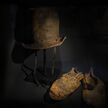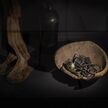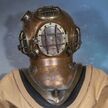A marine archeological exhibition at The Coastal Museum of Bangsbo
Jutland you are the mainland
Highland with forest loneliness
Wild in the west with dunes,
the sand rising instead of mountains.
The Baltic Sea and the North Sea
Embraced by the Skagen Beach.
translating of H.C. Andersen
In such a fine way nature in the northernmost part of Jutland was described by Hans Christian Andersen, the Danish poet. Through the years the area from the West Coast to the Peninsula of Skagen and further down the Kattegat has been dreaded by seafarers - with good reason. The land lies low which means low coastlines, the current is strong and there were not many lights on the long desolated land. This meant that thousands of ships wrecked and stranded along this coastline. However, what was bad for seafarers was good for the local population.
Life in Skagen and its neighbourhood was hard. Every day was a fight for survival. The soil was poor and if you were a fisherman like most people in Skagen you had to fight the fury of the sea. At the end of the 16th century the area around Skagen was ravaged by storms and floods. At the beginning of the 17th century there was a decline in fishery; life was difficult for local people.
Therefore the many strandings gave an opportunity as they meant prosperity to poor regions. You could earn a good salary by dismantling and scrapping stranded ships but you could also make money by auction sales of stranded goods. When “Det Grå Fyr” was established in 1858 following an order from the authority “Det kongelige danske fyrvæsen” people in Skagen experienced a noticeable fall in their earnings.
The sailing route from Skagerrak and further into the Kattegat is one of the world’s busiest routes with more than 60,000 ships passing every year – compared to 25,000 ships passing the Suez Canal. Of course there are figures from the present day but they tell how important this sailing route has been and still is for global trade and transport.
The marine archeological exhibition is based on four strandings: two Swedish warships (Spes and Öland), the English frigate Crescent and the Russian warship Perwoy. The exhibition describes the dramatic strandings, the marine archeological work and the items which were salvaged.






